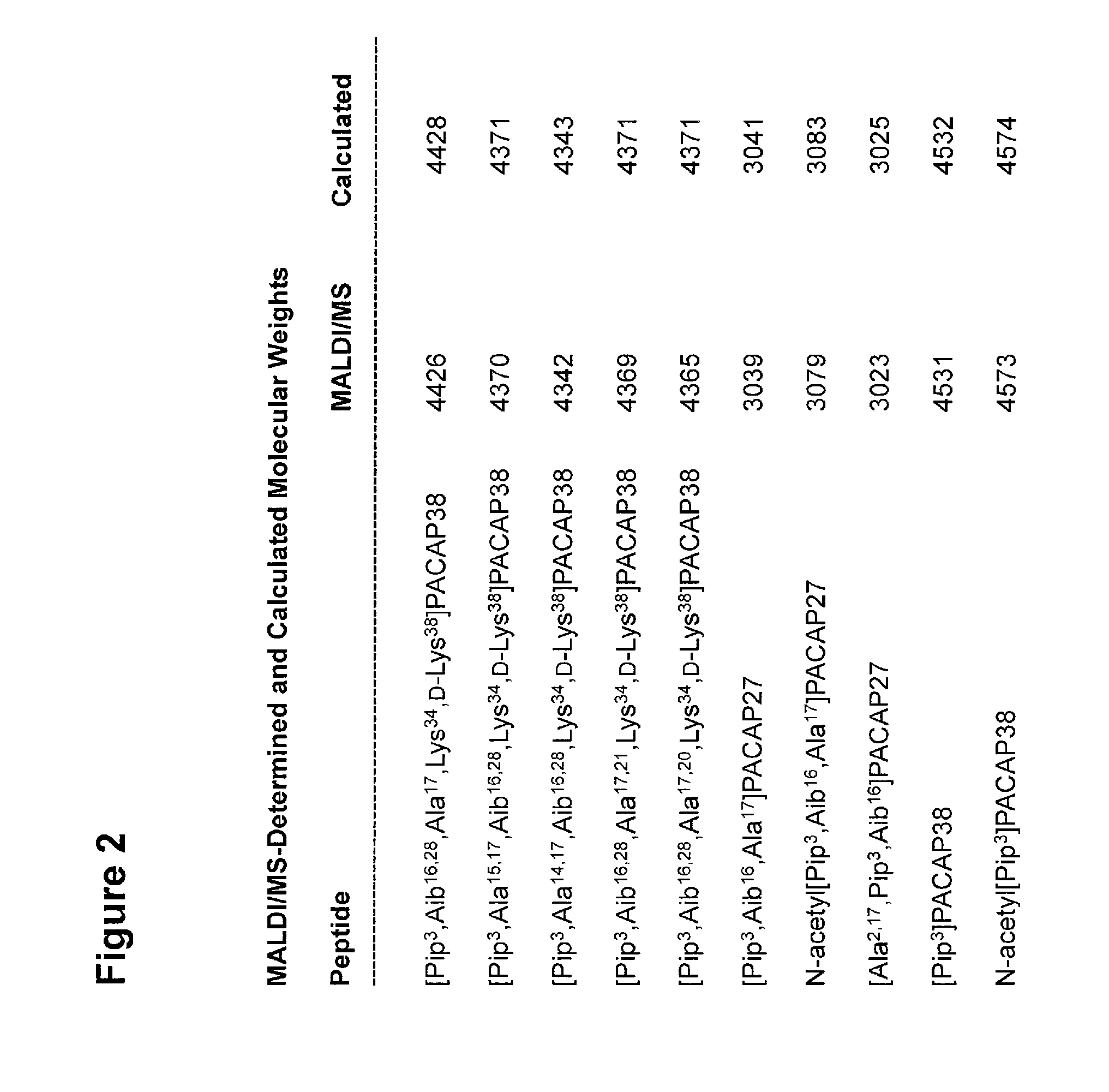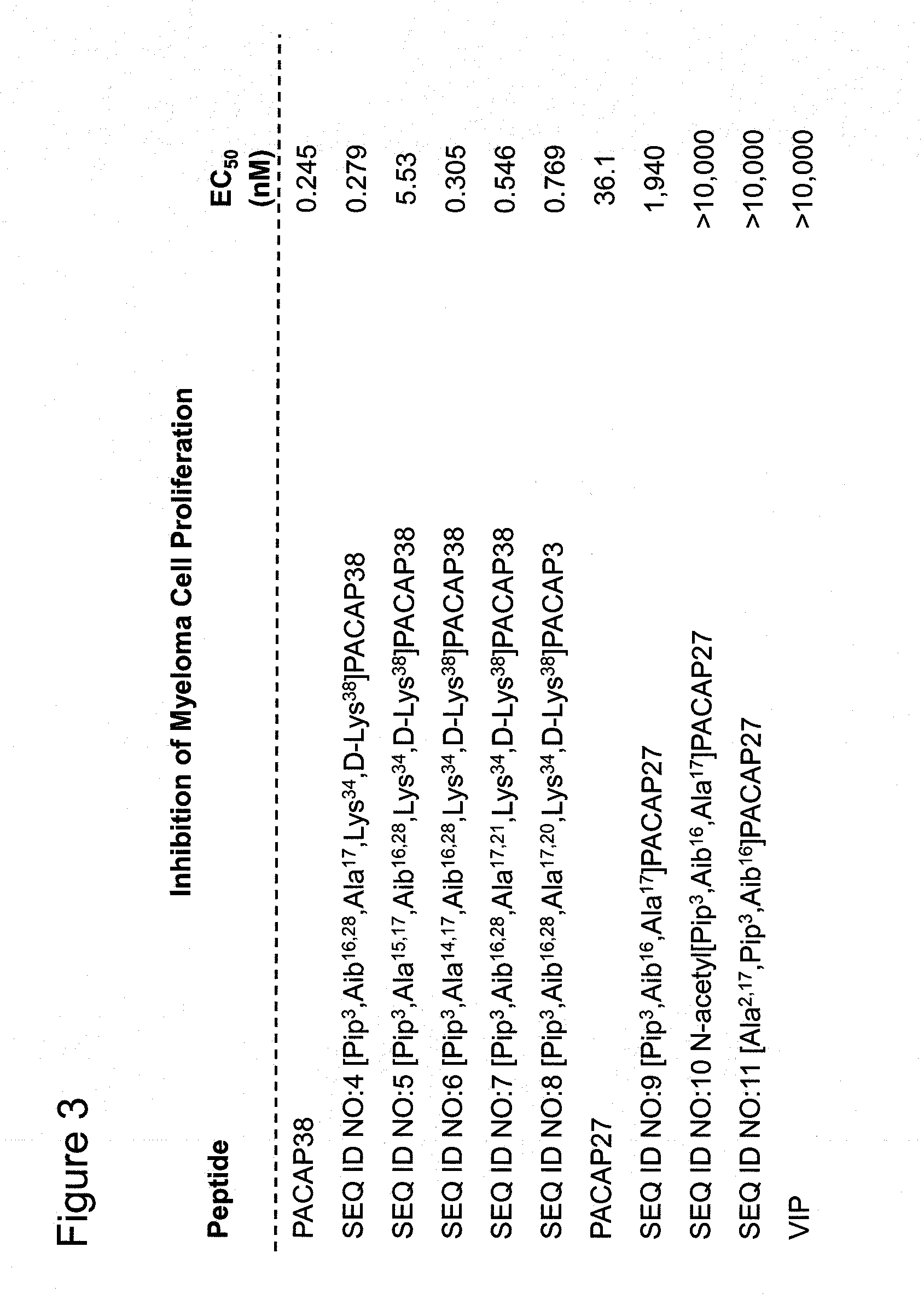Analogs of pituitary adenylate cyclase-activating polypeptide (PACAP) and methods for their use
a technology of cyclase activation and polypeptide, which is applied in the field of new analogs of pituitary adenylate cyclase activating polypeptide (pacap), can solve the problems of short half-life in the circulation after systematic administration of peptides, poor transport across the blood-brain barrier, and neuroprotective peptides in the brain. to achieve the effect of improving the efficacy of some anticancer agents
- Summary
- Abstract
- Description
- Claims
- Application Information
AI Technical Summary
Benefits of technology
Problems solved by technology
Method used
Image
Examples
example 1
Novel PACAP Analogs
[0264]Peptides can have extraordinarily high affinities for their cognate receptors. The major drawback of using native peptides as therapeutics is their short half-life in the circulation after parenteral administration due mainly to rapid proteolysis and rapid filtration by the kidney. Therefore, analogs of PACAP have been made in order to reduce the rates of proteolysis and / or renal clearance. In addition, other changes have been made in the native amino-acid sequences of PACAP27 and PACAP38 in order to reduce the cost of synthesis, and alter tissue distribution and / or receptor specificity.
[0265]Ten novel peptide analogs of PACAP27 or PACAP38 have been made by solid-phase synthesis (SEQ ID NOs: 4-13; FIG. 1 and FIG. 2) using the procedures briefly described above.
[0266]Some of the biological properties of nine of these ten PACAP analogs are illustrated below (FIGS. 3-10) and the potential medical applications of these novel PACAP analogs suggested by these illu...
example 2
Inhibition of the Proliferation of Multiple Myeloma Cells by PACAP38, PACAP27, VIP, and Novel PACAP Analogs
[0267]Multiple myeloma, a malignant cancer of plasma cells, is the sixth most common cancer in the USA. It accounts for about 10% of the hematological malignancies diagnosed in the USA. Multiple myeloma is slightly more prevalent in men than in women. The disease can cause serious medical complications, including bone resorption (osteolysis), hypercalcemia, anemia, thrombocytopenia, and kidney failure. Inflammation of the kidney is the second most frequent complication and occurs in about half of the patients with multiple myeloma. The cause of this inflammation is the overproduction by plasma cells of light-chain immunoglobulins (Bence-Jones proteins), which aggregate to form casts in the distal convoluted tubules and collecting ducts of the kidneys. Plasma cells are derived from activated B lymphocytes by clonal expansion. The normal restraints on the expansion of a single pl...
example 3
Reduction of Cisplatin-Induced Cytotoxicity by PACAP38, PACAP27 and Novel PACAP Analogs
[0270]Cisplatin (cis-diamminedichloridoplatinum(II), Platinol) is the first-in-class platinum-based DNA-crosslinking anticancer therapeutic. It was approved for clinical use by the U.S. FDA in 1978. The other members of this class of “alkylating-like” platinum-based anticancer agents now include (but are not limited to) carboplatin, oxaliplatin and satraplatin. Cisplatin is one of the most widely used cancer chemotherapeutics and is the cornerstone of many multi-drug anticancer regimens. Nephrotoxicity is usually the “dose-limiting” toxicity for the use of cisplatin in cancer chemotherapy, but sensory neuropathies can sometimes limit the doses that can be used to treat some patients.
[0271]Treatment of rat renal proximal tubule epithelial cells with cisplatin resulted in a large significant increase in apoptotic cell death (FIG. 5). The addition of PACAP38 to the medium at a concentration of 10-6 M...
PUM
| Property | Measurement | Unit |
|---|---|---|
| molecular weight | aaaaa | aaaaa |
| pore size | aaaaa | aaaaa |
| flow rates | aaaaa | aaaaa |
Abstract
Description
Claims
Application Information
 Login to View More
Login to View More - R&D
- Intellectual Property
- Life Sciences
- Materials
- Tech Scout
- Unparalleled Data Quality
- Higher Quality Content
- 60% Fewer Hallucinations
Browse by: Latest US Patents, China's latest patents, Technical Efficacy Thesaurus, Application Domain, Technology Topic, Popular Technical Reports.
© 2025 PatSnap. All rights reserved.Legal|Privacy policy|Modern Slavery Act Transparency Statement|Sitemap|About US| Contact US: help@patsnap.com



